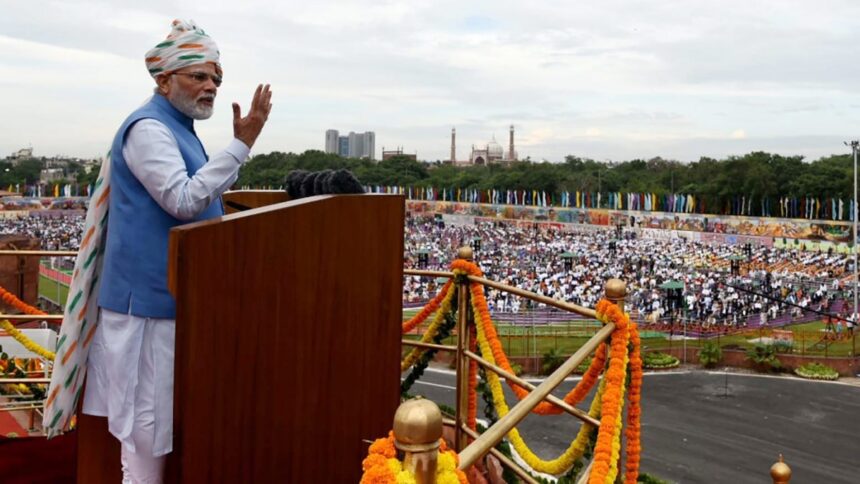After dethroning the UK to become the world’s fifth-largest economy, India has now set its eye on the third spot. Prime Minister Narendra Modi, who is gearing up for his re-election as the country’s leader for the third time, has assured the nation that India will become the third-largest economy in the world during his third tenure.
If elected for the third term, PM Modi will steer the country till 2029. With Tuesday’s Independence Day speech being his last as PM during the second term, the speech will set the tone for him making a pitch to be the prime minister for the third term.
Also read: From $5 tn to a developed nation: What PM Modi said about Indian economy in last 5 Independence Day speeches
As per many projections, India is expected to surpass Germany and Japan to hold the third position by 2030. This feat could be achieved even earlier than this by 2027 or 2028, according to a report by the State Bank of India’s Economic Research Department.
In a report released last month, SBI’s economists said that the path taken by India since 2014 revealed that the country is likely to get the tag of the third-largest economy in 2027 or FY28 based on actual GDP data as on March 2023.
India was the world’s tenth-largest economy in 2014.
With 3.7 trillion, India is currently the fifth largest economy after the US (26.8 trillion), China (19.3), Japan (4.4), and Germany (4.3). The economic growth in the US, Germany, and Japan has slowed down, with projections ranging from 1 to 1.4 per cent for 2024.
As per the World Bank’s Economic Outlook, the US is expected to grow at 1.4 per cent in 2024, while Germany at 1.1 per cent and Japan at 1 per cent. India, on the other hand, is projected to grow at 6.3 per cent in 2024, while China is to grow at 4.5 per cent. China’s economic growth too is expected to falter in the coming years due to a combination of factors including the decline in the working-age population.
In November last year, the global rating agency S&P said that India’s real GDP growth is projected to average 6.3 per cent annually in FY 2021-30, enabling it to overtake Japan and Germany to become the world’s third-largest economy (in nominal US dollar terms). The agency said that its forecasting data demonstrates India’s increasing role in global trade.
Between 2005 and 2021, the global firm said, the value of India’s exports increased by 279.5 per cent and imports increased by 301.6 per cent. The US, the UAE, and China accounted for about 30 per cent of India’s trade in 2021 (in value), and the country will pursue trade according to its concentric layers of strategic priority, S&P said.
The rating agency also highlighted India’s production-linked incentive (PLI) schemes in 13 sectors to boost domestic manufacturing. “It is very likely that the government is banking on PLIS as a tool to make the Indian economy more export-driven,” the agency said.
Weeks before S&P, US-based investment banking firm Morgan Stanley on November 8 last year predicted that India would become the third-largest economy by 2027 and have the third largest stock market by 2030, “thanks to global trends and key investments the country has made in technology and energy”.
“We believe India is set to surpass Japan and Germany to become the world’s third-largest economy by 2027 and will have the third-largest stock market by the end of this decade,” said Ridham Desai, Morgan Stanley’s Chief Equity Strategist for India.
The financial giant said India’s GDP could more than double from $3.5 trillion today to surpass $7.5 trillion by 2031. “Its share of global exports could also double over that period, while the Bombay Stock Exchange (BSE) could deliver 11% annual growth, reaching a market capitalization of $10 trillion in the coming decade.”
Chetan Ahya, Morgan Stanley’s Chief Asia Economist, India’s growth rate at a time when most of the large economies are facing a slowdown. He said in a world that is currently starved of growth, the opportunity set in India must be on global investors’ radar. Ahya said: “India will be one of only three economies in the world that can generate more than $400 billion annual economic output growth from 2023 onward, and this will rise to more than $500 billion after 2028.”
Goldman Sachs, another investment banking firm, recently said India will become the world’s second-largest economy by 2075. It said India has made more progress in innovation and technology than some may realise. “The country has demographics on its side, but that’s not going to be the only driver of GDP,” it said, adding that innovation and increasing worker productivity are going to be important for India.
“Favourable demographics will add to potential growth over the forecast horizon. India’s large population is clearly an opportunity,” Goldman Sachs said in a report published on July 6, 2023.







